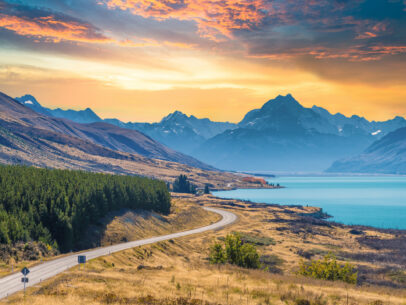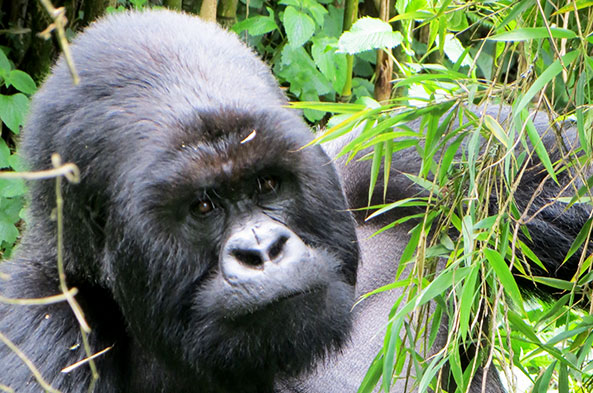
The Bird’s Word Blog
FAQ for Gorilla Safari Packages

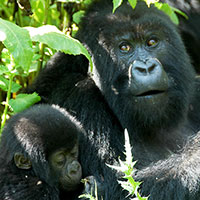 It’s the moment you’ll never forget. That moment when, after trekking through mountainous terrain, it’s time to remove your backpack and follow quietly. When the tracker pulls aside the brush, and you look through a green frame that moments ago was a tangle of vines and you see before you a proud, stoic and magnificent mountain gorilla. And you realize just how wonderfully, profoundly connected you are.
It’s the moment you’ll never forget. That moment when, after trekking through mountainous terrain, it’s time to remove your backpack and follow quietly. When the tracker pulls aside the brush, and you look through a green frame that moments ago was a tangle of vines and you see before you a proud, stoic and magnificent mountain gorilla. And you realize just how wonderfully, profoundly connected you are.
After many years leading trips in Uganda and Rwanda, led by our exceptional naturalist guide Paul Tamwanya, we’ve fine-tuned our expertise to know exactly where to go and how to get there. And, you won’t just meet mountain gorillas; you’ll also likely see other primates and many of the over 800 species of birds found in this region.
Here, we answer the most commonly asked questions about gorilla tracking and gorilla safari packages.
- Where and when can I track Mountain Gorillas?
- How can I visit Mountain Gorillas in Uganda and Rwanda?
- How many Mountain Gorillas are there?
- Does everyone have to buy a gorilla viewing permit?
How much do gorilla viewing permits cost? - How does gorilla tracking compare in Rwanda and Uganda?
Where is the best place to track gorillas? - How difficult is Gorilla Trekking?
How fit must I be to track Mountain Gorillas? - How much time can I spend with the Mountain Gorillas?
- How close can I get to the Mountain Gorillas?
- Are the Mountain Gorillas dangerous?
- How old must you be to track Mountain Gorillas?
- Where can I stay near the gorillas during my safari?
- How do Mountain and Lowland Gorillas compare?
How can I see Lowland Gorillas? - What else is there to see in Rwanda besides Mountain Gorillas?
- What else is there to see in Uganda besides Mountain Gorillas?
- How does Chimpanzee Tracking work?
- Tips for a successful Mountain Gorilla Tracking Safari
Where and when can I track Mountain Gorillas?
Mountain Gorilla tracking is done every day of the year in Uganda and Rwanda. While there are gorillas in the Democratic Republic of the Congo, very few tourists choose to track Mountain Gorillas there due to security concerns and lack of organized services.
The most comfortable times for gorilla trekking are the dry seasons, July-September and December-February. It can and does rain every month and the effects of climate change are quite evident in this area of East Africa, with seasonal rains being much less predictable and sometimes more intense. All gorilla tracking parties leave around 8 am when heavy rain is less likely. If you happen to be assigned a distant gorilla group requiring four or more hours of tracking, your chances of returning in the rain increase.
How can I visit Mountain Gorillas in Uganda and Rwanda?
Most tourists visit the Mountain Gorillas with the assistance of tour operators like Journeys International. Journeys arranges the necessary permits, transportation, guides, and lodging required for Mountain Gorilla tracking. You are not permitted to search for Mountain Gorillas on your own or outside designated areas.
All of the remaining Mountain Gorillas in the wild reside in the volcanic mountain ranges along the borders of Uganda, Rwanda, and The Congo.
How many Mountain Gorillas are there?
Numbers are imprecise but estimates in 2024 are at about 1000. Not all are in habituated groups accessible to tourists.
Does everyone have to buy a gorilla viewing permit? How much do gorilla viewing permits cost?
You must purchase gorilla viewing permits in advance of your trip. Permits are limited and sell out quickly, so we recommend reserving yours at least one year ahead of your departure.
Current cost of gorilla viewing permits (in 2024) is $1,500 in Rwanda and $800 in Uganda for a one-hour visit in a group of eight visitors. This does not include transportation from the registration and orientation site to the hiking departure point or trailhead, which may be up to 25 miles away. If you travel with Journeys, we take care of your transportation.
Additional fees: You will want to tip your park guide and trackers about $20 each. We highly recommend you also hire a porter at an additional cost of $20 per trek, as they help carry your daypack and assist with your trekking when necessary. Plus, you provide additional income to the local community which encourages conservation of the wildlife, rather than poaching.
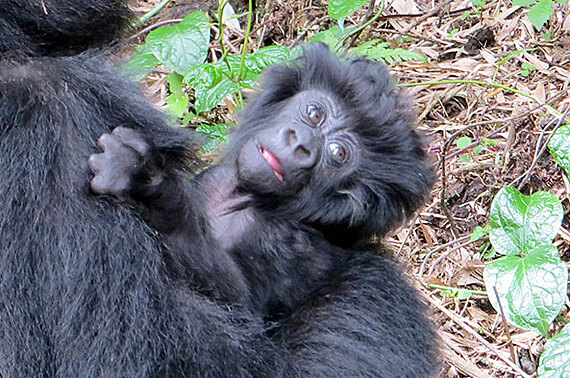
How does gorilla tracking compare in Rwanda and Uganda? Where is the best place to track gorillas?
Mountain Gorillas tracking is very similar in Rwanda and Uganda, with similar rugged terrain and habits among the gorillas. And, the regulations and quality of local gorilla guides and trackers is also very similar in Rwanda and Uganda.
It’s impossible to predict exactly where the gorilla groups will be during your trek, though, since you need to plan so far ahead to get your permit. Sometimes Mountain Gorilla family groups travel rapidly, break up and reform, or show behaviors that make them less attractive to visit. Other times, gorilla groups travel into the Congo or beyond the range of a day trek. And some habituated Mountain Gorilla groups are dedicated to research and not open to tourist tracking.
Our guides at Journeys are experts at keeping tabs on the gorillas, though, and do an excellent job of giving visitors the best chance to see as many gorillas as possible.
How difficult is Gorilla Trekking? How fit must I be to track Mountain Gorillas?
Altitude sickness is not usually a problem, nor are insects, but you must be able and willing to hike in rough terrain and in any weather to see Mountain Gorillas in the wild. Many people who are not used to vigorous hiking return very exhausted, muddy, and sore.
That said, many older people who don’t think of themselves as hikers or adventurers can successfully visit the gorillas. We have had numerous clients in their 70’s reach their target Mountain Gorilla groups.
The local guides will work to make it as easy as possible for you to track and photograph the Mountain Gorillas. Here are a few tips to help you reach the gorillas:
- Hire a porter (personal assistant) to carry your daypack and assist you in difficult areas.
- Wear a pair of gloves and clothing that protects your arms and legs from thorns and nettles.
- Good balance is helpful in Gorilla trekking as trails may be slippery, so walking sticks can be a welcome addition.
How much time can I spend with the Mountain Gorillas?
Your Mountain Gorilla viewing permit allows you to spend one hour with a habituated group of Mountain Gorillas. Sometimes your guide may allow you a few more minutes, especially if you have had a long trek to reach them and the tourist group is not disturbing the gorillas. Even with the one-hour limit, all Journeys clients are thrilled and report that the effort was worth it.
How close can I get to the Mountain Gorillas?
Officially you are required to keep a 27-foot distance from the gorillas. In practice, the Mountain Gorillas often violate this rule by coming closer to you as you stand quietly observing or photographing them. It is still helpful to have telephoto capability on your camera since some animals are shy, and the Silverback may be very protective of the young. You are not allowed to touch the gorillas, though it would be easy to do so.
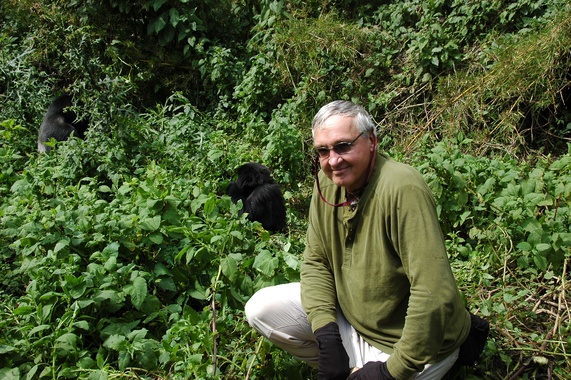
Are the Mountain Gorillas dangerous?
All wild animals should be considered potentially dangerous and treated as such, but Mountain Gorillas are not aggressive or prone to be angered by tourists. Many people are surprised that the Mountain Gorillas seem to ignore the tourists in their midst completely. But you should not get between a mother and a baby or tease animals, use a flash, make distracting noises, or move quickly.
How old must you be to track Mountain Gorillas?
There is a minimum age of 15 years for anyone obtaining a permit to track Mountain Gorillas in Uganda or Rwanda. Park Authorities will check the age of all permit holders against the birthdate on your passport.
Where can I stay near the gorillas during my safari?
There are many lodges in Rwanda and Uganda that offer a range of accommodations, vehicles, airport transfers, and other safari services. Journeys uses a variety of accommodations in the higher comfort ranges.
How do Mountain and Lowland Gorillas compare? How can I see Lowland Gorillas?
Mountain Gorillas and Lowland Gorillas are separate species of Gorillas. Their current ranges do not overlap. There are few, if any, Lowland Gorillas in Uganda or Rwanda, though this species is widespread in the rainforests of central Africa. Few Lowland Gorilla groups are habituated for tourists and, in general, they are difficult to see and observe. Lowland gorillas are widely hunted for bushmeat in unprotected areas of their range. Some opportunities exist to see Lowland Gorillas in Gabon and Central African Republic.
What else is there to see in Rwanda besides Mountain Gorillas?
Rwanda is a beautiful, green, thriving country, known as the Land of a Thousand Hills. The volcanic soil is very rich and subsistence agriculture produces food year-round. The genocide of 1994 is powerfully memorialized in a museum in Kigali and at other sites around the country. Visitors are encouraged to partake in these experiences and learn from them. Currently, there is no apparent ethnic conflict or significant insurgent or militant activity. There is a dynamic rebuilding of the social fabric and a commitment to the youth of the country. You might wish to hike to Karisoke where Diane Fossey conducted her pioneering research, or take a trek to see Golden Monkeys of Parc des Volcanes. Other wildlife parks of Rwanda generally do not compare in diversity of species or quality of management with the parks and reserves of Uganda, Kenya, and Tanzania.
What else is there to see in Uganda besides Mountain Gorillas?
Travel to Uganda for wonderful cultures, large wildlife parks with few other tourists, and spectacular birding. Uganda may be the best safari country in Africa for a large variety of bird species and great birding safari habitats. Determined birders often see more than 400 species on a 12-14 day Uganda birding safari. There are also many other species of primates you are likely to see on a Mountain Gorilla safari or a pure birding safari trip. The Ruhenzori Mountains invite more extended hiking. Wetland habitats and Lake Victoria also hold cultural and natural history safari attractions. Our Primates and Parrots in Uganda and Rwanda extension itinerary is an excellent comprehensive adventure that opens up these opportunities and more.
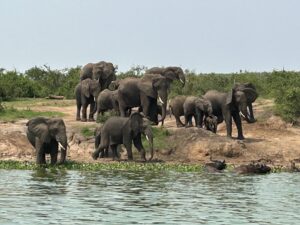
How does Chimpanzee Tracking work?
There are more Chimpanzees than Mountain Gorillas left in the wild and they survive over a much broader range. The parks authorities of Uganda and Rwanda also monitor Chimpanzee populations, and, as with gorillas, the groups which have been habituated for tourist visitors also require advance purchased permits to visit.
Two main sites for viewing chimpanzees in Uganda are Kibale Forest and Kyambura Gorge. You will hike in groups of 6-12 visitors accompanied by a park guide. Close encounters with Chimpanzees seem to be less predictable than with Mountain Gorillas, though less hiking may be involved. In the experience of Journeys International groups, visits to the Chimps of Kibale Forest have been more successful than visits to Kyambura Gorge.
Tips for a successful Mountain Gorilla Tracking Safari
- Purchase your permits as far in advance as possible for priority assignment to a choice group.
- Consider hiring a local person as a porter, even if you are very fit. This adds a great cultural dimension to the experience for a minimal cost.
- If you have the choice, visit the largest group available to you to maximize the photo opportunities and the different behaviors you can see among the gorillas.
- Prepare for the possibility of rain at any time of year.
- Wear long sleeves and slacks and bring gloves to protect against thistles nettles and thorns.
- You will be required to wear a mask to prevent the spread of disease to the gorillas.
- Wear durable hiking shoes, since you will be off-trail in rough terrain.
- Expect a long hike, and be in the best physical shape you can be.
- Consider traveling with a companion or friend with whom you will share the lifelong memory of the encounter.
- Listen to the advice of your guide. Trust that he or she really wants you to get great photos and have the best possible experience.
Gorilla Safari Packages with Journeys
After many years leading gorilla trekking trips in Uganda and Rwanda, led by our exceptional naturalist guide Paul Tamwanya, we’ve fine-tuned our expertise to know exactly where to go and how to get there. Let us know you’re interested and we’ll be in touch to answer all of your questions about gorilla tracking.
I’m interested in gorilla tracking package
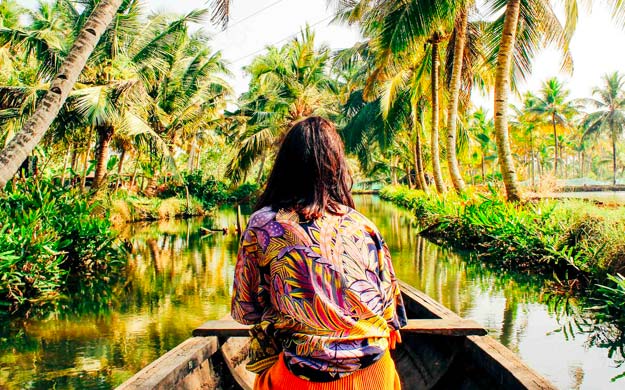
Design an adventure with Journeys International!
With over 40 years of experience, we create experiences that match your goals.
Start Planning